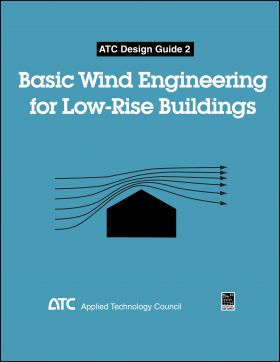The ATC Design Guide 2 report, Basic Wind Engineering for Low-Rise Buildings, was developed with funding from ATC's Henry J. Degenkolb Memorial Endowment Fund. (Published 2009, 114 pages)
ABSTRACT: This report provides background information and guidance on wind engineering provisions for low-rise buildings contained in ASCE 7-05, Minimum Design Loads for Buildings and Other Structures, and the 2009 International Building Code (IBC). Treatment is limited to common building types and buildings under 60 feet in height.
The ATC Design Guide 2:
- summarizes background information related to both atmospheric and aerodynamic effects of high winds on buildings;
- describes and explains generalized wind provisions, including important parameters and equations required to determine wind pressures;
- guides the user on the application of ASCE 7-05 methodologies for determining wind pressures using the Analytical Procedure, the Simplified Procedure and the IBC procedure;
- guides the user on methodologies for determining wind pressures for unusual conditions, including but not limited to parapets, canopies, roof-top equipment, soffits, and overhangs; and
- includes several design examples using various methods with commentary concerning any differences in results between the methods.
Tall buildings, dynamic effects, non-building structures, and wind tunnel applications are beyond the scope of this document.
This document is the second in a series of Design Guides developed by the Applied Technology Council, with funding in part from the ATC Endowment Fund. The series is intended to provide succinct, state-of-the-art information on important design issues for practicing structural engineers. The first such document, ATC Design Guide 1, Minimizing Floor Vibration, was published in 1999.
View Title Page, Preface, and Contents here.
